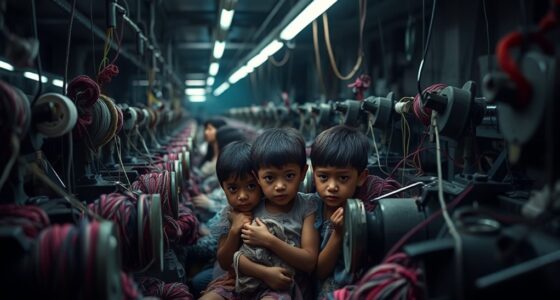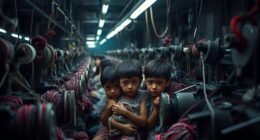Climate change is pushing the synthetic fiber industry to find greener alternatives. You’ll see more recycled, plant-based, and bio-derived fibers that reduce pollution and carbon emissions. Advances in recycling tech and eco-friendly manufacturing help cut waste and dependence on non-renewable resources. Industry standards and collaborations are speeding up sustainable practices. To discover how these innovations are shaping a cleaner future and what challenges remain, keep exploring these evolving trends.
Key Takeaways
- Climate change drives innovation toward sustainable, eco-friendly synthetic fibers with reduced carbon footprints and pollution impacts.
- Recycling technologies, such as chemical and mechanical recycling, enable reuse of fibers, minimizing waste and resource depletion.
- Growing consumer demand for recycled and biodegradable fibers encourages industry shifts toward circular economy principles.
- Regulatory standards and eco-labeling promote transparency and responsible manufacturing of sustainable fibers.
- Collaboration among industry, governments, and research institutions accelerates development of biodegradable and low-impact synthetic fibers.
The Environmental Impact of Conventional Synthetic Fibers
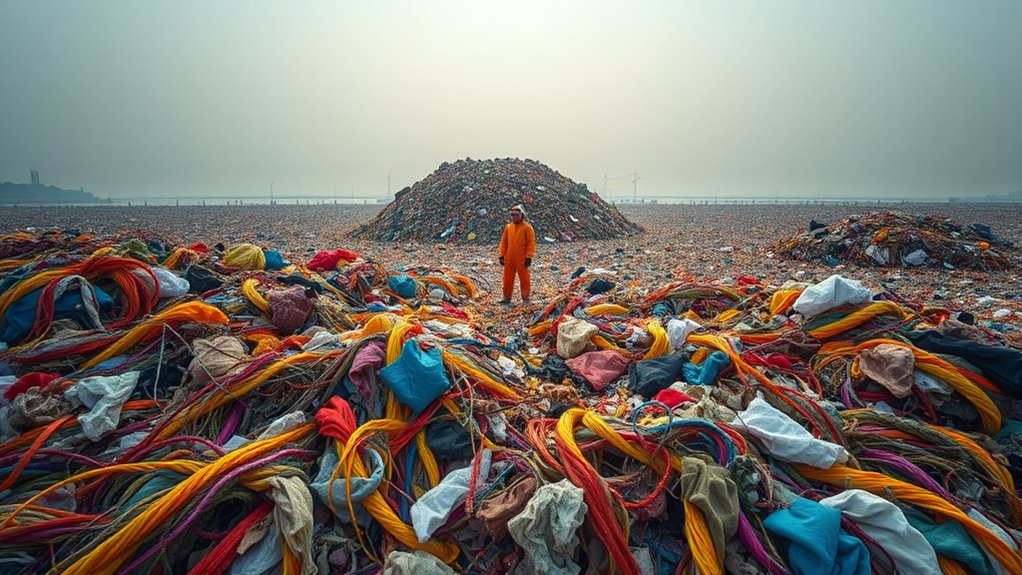
Conventional synthetic fibers like polyester and nylon have a significant environmental footprint, primarily due to their production processes. When you produce these fibers, you contribute to environmental pollution through greenhouse gas emissions and chemical waste. Their manufacturing requires extensive water consumption, putting pressure on local water sources and ecosystems. This high water use often leads to water pollution when chemicals from production leak into nearby rivers and lakes. Additionally, the energy-intensive processes release pollutants into the atmosphere, worsening air quality. As a result, these fibers not only deplete natural resources but also harm wildlife and communities. Your choices in fiber production impact the environment, making it essential to contemplate sustainable alternatives that reduce water use and minimize pollution. Understanding the environmental impact of synthetic fibers is crucial for developing more eco-friendly textile options.
Climate Change as a Catalyst for Innovation in Fibers

Climate change pushes the fiber industry to develop sustainable materials that reduce environmental impact. You’ll see innovations in recycling technologies that make it easier to reuse and repurpose fibers. These advances not only address climate concerns but also open new opportunities for eco-friendly fiber production. Additionally, the focus on recycling technologies encourages the industry to adopt more efficient and environmentally conscious practices.
Sustainable Material Development
The urgent need to address climate change has become a powerful driver for innovation in fiber development. You’re now exploring sustainable materials that reduce environmental impact. Recycled polymers play a key role, allowing you to transform plastic waste into high-quality fibers, cutting down on landfill buildup and resource consumption. Plant-based fibers, derived from renewable sources like hemp, bamboo, or soy, offer another eco-friendly alternative, decreasing reliance on fossil fuels. These innovations help lower carbon footprints and promote circular economies. By focusing on sustainable material development, you’re contributing to a future where fibers are both functional and environmentally responsible. This shift not only aligns with global climate goals but also meets consumer demand for greener products, ensuring the textile industry’s resilience in a changing world. Additionally, incorporating wall organization systems can facilitate efficient storage and display of eco-friendly textiles and fibers, promoting sustainable home decor practices.
Enhanced Recycling Technologies
Innovations in recycling technologies are transforming how the textile industry manages waste, driven by the urgent need to reduce environmental impact. You now have access to innovative recycling methods that break down synthetic fibers into their basic components, enabling true material innovation. These advanced techniques allow you to recycle fibers more efficiently, turning waste into high-quality raw materials for new textiles. By adopting these technologies, you can reduce reliance on virgin resources and lower carbon emissions associated with fiber production. Enhanced recycling not only minimizes landfill waste but also promotes a circular economy within the industry. As climate change accelerates, these innovations become essential tools, empowering you to create sustainable fibers and contribute to a healthier planet. Proper storage and handling of synthetic fibers is also crucial to maintain their quality and recyclability over time.
Biobased and Renewable Alternatives in Fabric Production
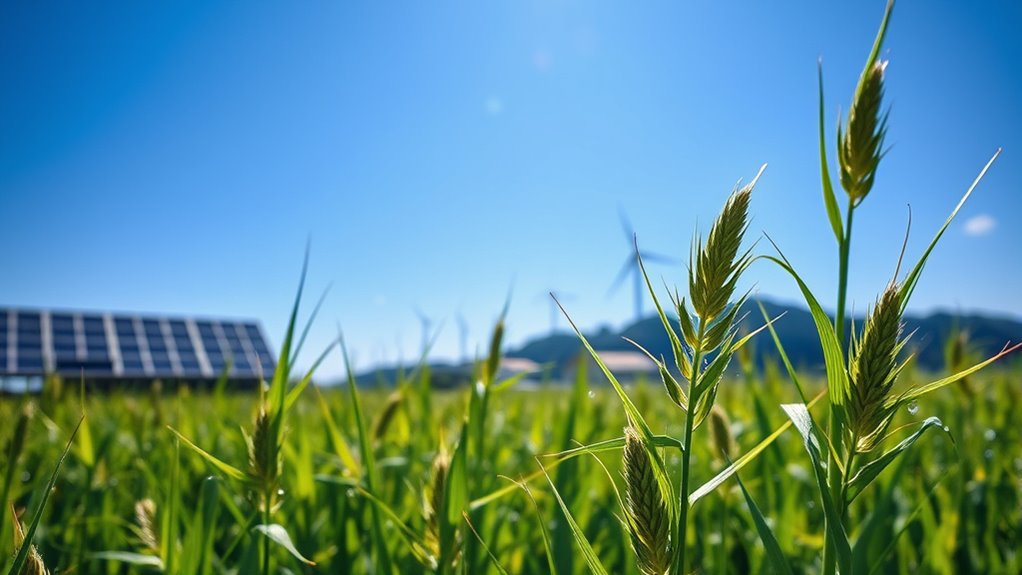
You can choose eco-friendly raw materials that reduce environmental impact, such as plant-based fibers. Sustainable manufacturing processes further lower carbon footprints and conserve resources. Additionally, biobased fabrics offer better biodegradability and recyclability, helping to close the loop in textile production. Incorporating diverse beach experiences and eco-conscious materials can promote sustainability in the fashion industry.
Eco-Friendly Raw Materials
As awareness of environmental impacts grows, fabric producers are increasingly turning to biobased and renewable raw materials to create eco-friendly textiles. By using biobased polymers, they reduce reliance on fossil fuels and lower greenhouse gas emissions. These polymers are derived from renewable feedstocks like plant fibers, agricultural waste, or algae, making the production process more sustainable. Choosing renewable feedstocks means sourcing raw materials that replenish naturally and have a smaller environmental footprint. This shift not only helps conserve finite resources but also promotes a circular economy. As a result, textiles made from these eco-friendly raw materials are more biodegradable and less polluting during manufacturing and disposal. Incorporating AI analytics can further optimize the sourcing and production processes to enhance sustainability. Embracing biobased polymers is an essential step toward a greener, more sustainable future in fabric production.
Sustainable Manufacturing Processes
To minimize environmental impact, fabric producers are increasingly adopting sustainable manufacturing processes that utilize biobased and renewable alternatives. These methods focus on innovative dyeing techniques that reduce water and chemical use, making the process more eco-friendly. Water conservation is a key goal, achieved through advanced technology that minimizes water waste during dyeing and finishing. By shifting to renewable resources, manufacturers lower carbon emissions and decrease reliance on fossil fuels. This approach also encourages the development of dyes derived from plant-based sources, reducing toxic runoff. Implementing sustainable processes not only helps combat climate change but also appeals to eco-conscious consumers. Overall, these strategies promote a greener fabric production cycle, ensuring sustainability without compromising quality or performance.
Biodegradability and Recycling
How can fabrics be designed to break down naturally and reduce environmental waste? By embracing biodegradable materials and innovative recycling methods, you can help combat pollution. Biodegradability challenges often stem from synthetic fibers that persist in landfills, but research into biobased and renewable alternatives offers hope. Recycling innovations enable fabrics to be reused efficiently, minimizing waste and resource consumption. Imagine a future where your clothing:
- Decomposes harmlessly after use
- Reduces landfill overflow
- Empowers sustainable fashion choices
- Supports eco-friendly production
- Inspires industry-wide change
These advancements make it possible to create textiles that not only serve your needs but also protect our planet. You can be part of the solution by choosing fabrics designed with biodegradability and recycling in mind, fostering a cleaner, greener future.
Advances in Recycling Technologies for Synthetic Textiles
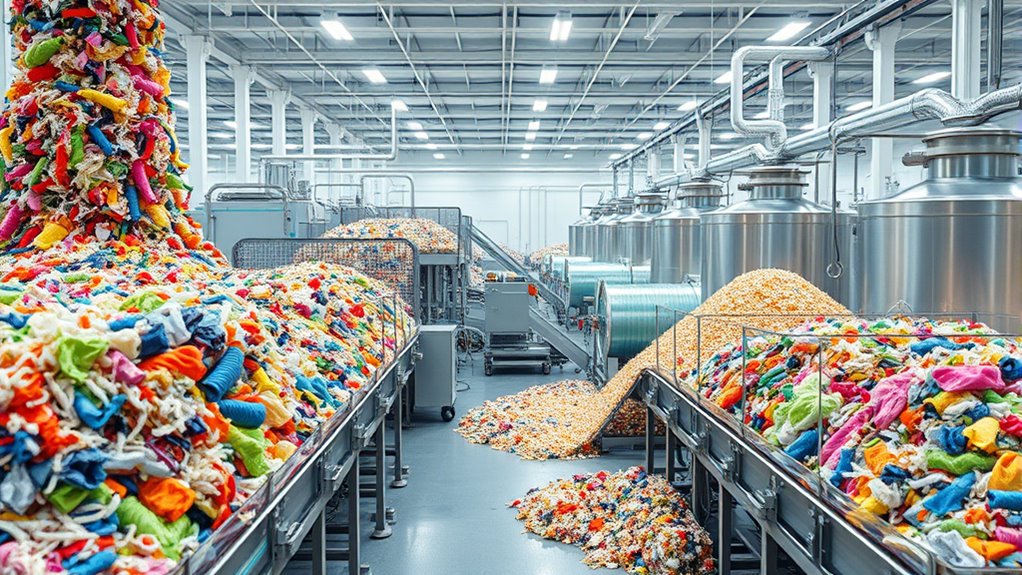
Recent breakthroughs in recycling technologies are transforming the way synthetic textiles are repurposed, making the process more efficient and environmentally friendly. These innovations, driven by fiber innovation and recycling breakthroughs, enable you to recover valuable materials from discarded fabrics more effectively. Advanced methods like chemical recycling break down fibers into their basic monomers, allowing for high-quality fiber regeneration. Mechanical recycling, on the other hand, involves shredding textiles into fibers for new products, reducing waste. These technologies minimize pollution and energy use while maximizing material reuse. The table below highlights key advancements:
| Technology | Benefit | Impact |
|---|---|---|
| Chemical Recycling | Restores fiber quality | Reduces landfill waste |
| Mechanical Recycling | Cost-effective, scalable | Lowers environmental footprint |
| Fiber Innovation | New sustainable fibers | Enhances recycling efficiency |
The Role of Industry Standards and Policies in Promoting Sustainability

Industry standards and policies play a vital role in driving sustainable practices across the synthetic fiber sector. Strengthening regulatory frameworks, establishing clear certification and labeling standards, and fostering industry collaboration can considerably reduce environmental impacts. By engaging with these initiatives, you can help promote accountability and innovation in sustainable textile production. Additionally, implementing sound healing science principles into manufacturing processes may offer new avenues for reducing stress and improving worker well-being in the industry.
Regulatory Frameworks Enhancement
Enhancing regulatory frameworks is essential for guiding the sustainable development of synthetic fibers. Strong policy reforms and effective regulatory oversight can drive industry-wide change, making sustainability a priority. By tightening standards, you can guarantee companies reduce environmental impact and adopt eco-friendly practices. Consider these key impacts:
- Protecting ecosystems and communities from pollution
- Encouraging innovation in sustainable fiber production
- Building consumer trust through transparent policies
- Holding industries accountable for environmental commitments
- Accelerating progress toward climate goals
These measures evoke hope and confidence that positive change is possible. You have the power to influence policies that shape a greener future. Strengthening frameworks is not just regulation; it’s a call to action for a sustainable tomorrow. Prophetic dreams can symbolize the importance of foresight and proactive planning in creating a sustainable future.
Certification and Labeling Standards
Certification and labeling standards play a crucial role in guiding the sustainable development of synthetic fibers by providing clear benchmarks for environmental performance. Eco labeling standards help consumers identify products that meet specific sustainability criteria, encouraging responsible choices. These standards set certification benchmarks that manufacturers must meet, ensuring transparency and accountability throughout the supply chain. By adhering to recognized eco labels, you can verify that fibers are produced with minimal environmental impact, such as reduced emissions or recyclability. Certification programs also incentivize innovation, pushing companies to improve their practices. Ultimately, these standards empower you to make informed decisions, support sustainable brands, and promote industry-wide progress toward environmentally responsible synthetic fibers. Additionally, natural materials like linen and reclaimed wood are increasingly integrated into sustainable textile designs, emphasizing the importance of eco-conscious choices across related industries.
Industry Collaboration Initiatives
Collaborative efforts among companies, governments, and organizations are essential for establishing effective standards and policies that drive sustainability in synthetic fibers. Industry partnerships and innovation hubs foster shared knowledge, accelerate eco-friendly innovations, and set unified sustainability goals. These initiatives inspire collective responsibility and amplify impact. By working together, you can help:
- Reduce environmental footprints through joint research
- Promote transparency with clear sustainability metrics
- Drive policy changes that favor eco-conscious practices
- Accelerate the development of greener synthetic fibers
- Build consumer trust in sustainable products
Participation in industry collaborations empowers you to be part of a larger movement toward responsible manufacturing. Innovation hubs serve as catalysts for breakthrough solutions, making sustainable fibers more accessible and effective. Your involvement ensures a future where industry standards prioritize planetary health.
Consumer Demand and Market Shifts Toward Eco-Friendly Materials

As awareness of climate change grows, consumers are increasingly demanding eco-friendly materials in their clothing and everyday products. You’re likely noticing a shift in consumer preferences toward sustainable options, driven by concerns about environmental impact. Market trends reveal that brands are responding by offering more products made from recycled fibers and biodegradable materials. This shift influences purchasing decisions, with many shoppers prioritizing eco-conscious brands over traditional ones. Your choices, from clothing to home goods, now reflect a desire for transparency and sustainability. Companies that adapt quickly to these demands gain a competitive edge, reinforcing the importance of eco-friendly materials in the marketplace. Overall, consumer demand is reshaping market trends, pushing industries toward more sustainable synthetic fiber options. Additionally, the rise of DIY tiny house construction demonstrates a growing interest in sustainable living practices.
Challenges in Scaling Sustainable Synthetic Fiber Production

Scaling sustainable synthetic fiber production faces significant hurdles, despite the growing demand for eco-friendly materials. You encounter obstacles like complex supply chain logistics, which can delay or increase costs. Sourcing raw materials sustainably adds pressure, as environmentally responsible options are limited and often more expensive. You also face inconsistent quality control, making large-scale production challenging. Limited infrastructure for eco-friendly processes hampers growth. Additionally, regulatory hurdles and fluctuating policies create uncertainty, discouraging investment.
Here’s what you confront:
- Disrupted supply chains causing delays
- High costs of ethically sourced raw materials
- Limited access to eco-friendly processing facilities
- Regulatory complexities slowing innovation
- Market hesitation due to production risks
These challenges make scaling sustainable fibers a complex, urgent task.
Case Studies: Companies Leading the Green Revolution
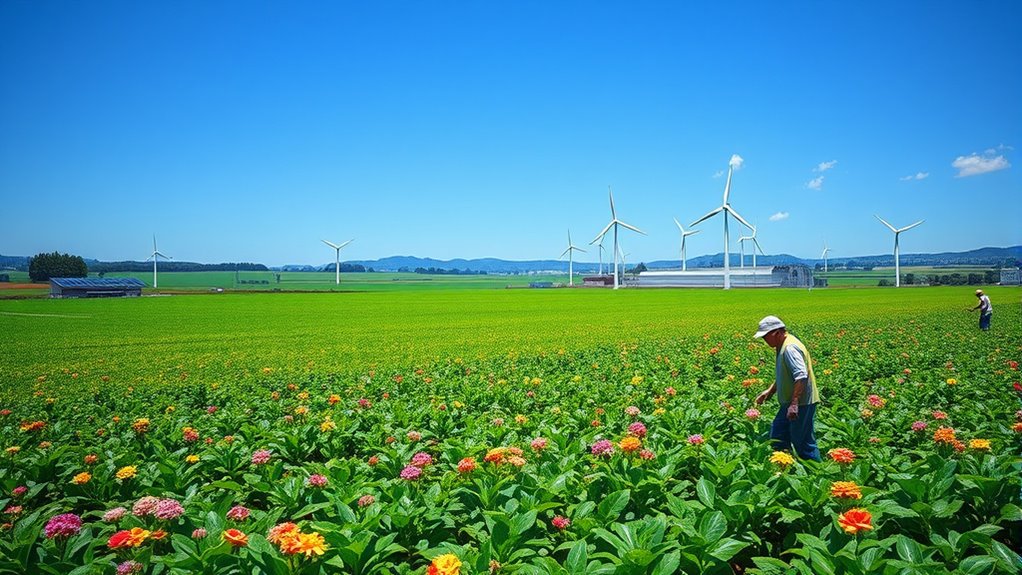
Several innovative companies are making strides in the green revolution for synthetic fibers, demonstrating that sustainable production is achievable despite widespread challenges. These leaders prioritize textile innovation, combining eco-friendly materials with advanced manufacturing processes to reduce environmental impact. By focusing on brand sustainability, they showcase that profitability and responsibility can go hand in hand. For example, some brands develop fibers from recycled plastics, cutting waste and energy use, while others invest in bio-based alternatives. These companies set benchmarks for transparency and accountability, encouraging industry-wide change. Their efforts prove that sustainable synthetic fibers are not just a possibility but a practical reality, inspiring others to adopt greener practices and rethink traditional textile production methods for a more sustainable future.
Future Perspectives: Integrating Circular Economy Principles
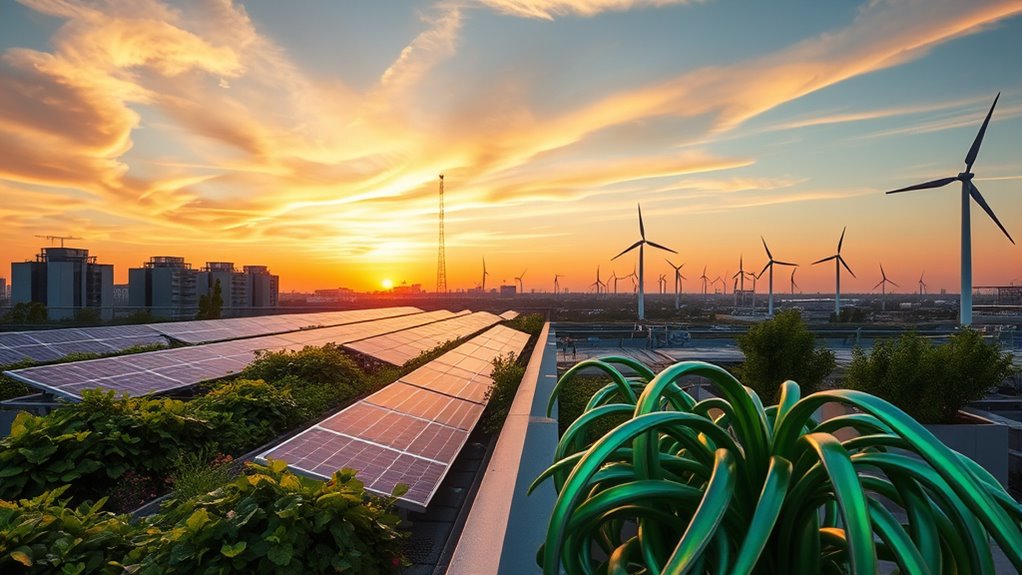
The integration of circular economy principles into the synthetic fiber industry offers a promising pathway toward sustainability. By embracing fiber innovation and rethinking waste, you can transform how fibers are produced, used, and recycled. This shift encourages designing products that are easier to remake, reuse, or repurpose, reducing environmental impact. Imagine a future where discarded fibers become new raw materials, closing the loop and conserving resources. You’ll feel empowered to support sustainable practices that protect the planet.
- Reduce waste and pollution
- Create durable, recyclable fibers
- Foster innovation that minimizes resource use
- Inspire industry-wide change
- Build a resilient, sustainable future
Collaborations and Research Initiatives Shaping the Path Ahead
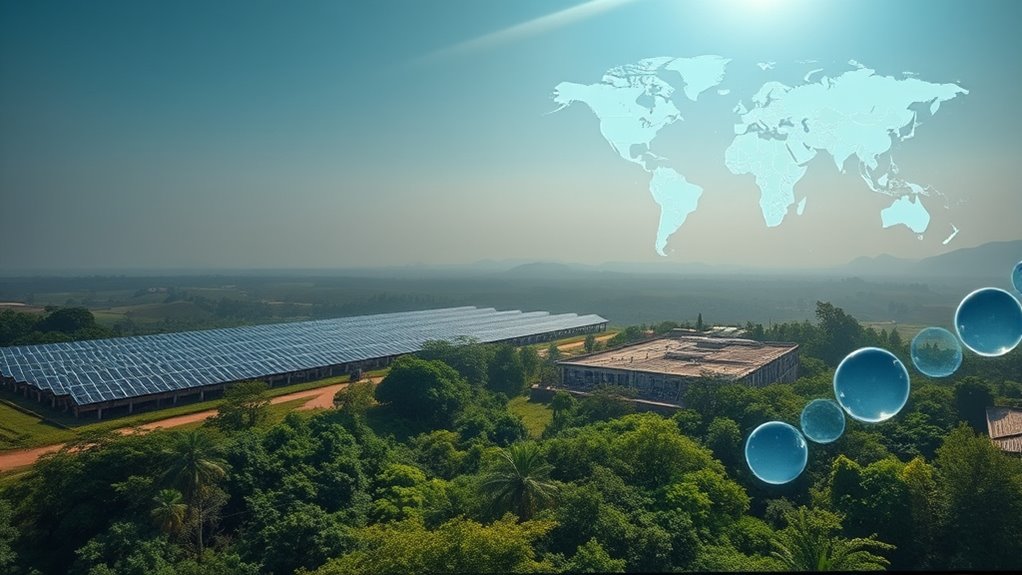
Collaborations and research initiatives are driving innovation in the synthetic fiber industry, shaping a more sustainable future. By pooling resources and expertise, industry leaders, academia, and governments are accelerating technological breakthroughs that reduce environmental impact. These partnerships are often motivated by economic incentives, like funding grants and market growth, encouraging companies to develop eco-friendly fibers. Initiatives focus on creating biodegradable options, recycling technologies, and energy-efficient manufacturing processes. To visualize this, consider the following ideas:
| Partnership Type | Focus Area | Benefits |
|---|---|---|
| Industry-Academia | Innovative fibers | Faster innovation cycles |
| Public-Private | Recycling tech | Reduced waste |
| International | Sustainable standards | Global adoption |
| Tech Companies | Manufacturing | Cost reduction |
| NGOs | Eco-certifications | Consumer trust |
These collaborations are essential for driving progress toward sustainable synthetic fibers.
Frequently Asked Questions
How Will Synthetic Fiber Production Adapt to Future Climate Policies?
You’ll see synthetic fiber production adapt by focusing on reducing its carbon footprint through eco-friendly manufacturing processes. Companies are investing in cleaner technologies, like renewable energy and recycled materials, to meet future climate policies. You’ll notice innovations aimed at lowering emissions and waste, making production more sustainable. This shift helps businesses stay compliant and aligns with increasing consumer demand for environmentally responsible products.
What Are the Economic Impacts of Shifting to Sustainable Fibers?
Imagine riding a turbulent sea of market volatility, where shifting to sustainable fibers feels like steering through unpredictable waves. You’ll face higher labor costs as industries adapt, but this changeover can open new economic opportunities. While initial investments may strain budgets, long-term gains include a resilient, eco-conscious market. Embracing sustainable fibers may challenge your current operations, but it positions you for growth amid evolving consumer demands and environmental priorities.
How Do Consumer Preferences Influence Sustainable Fiber Innovation?
You influence sustainable fiber innovation through your consumer demand and eco-conscious choices. When you prioritize eco-friendly options, brands respond by developing new, sustainable fibers to meet your expectations. Your preferences drive companies to invest in research and adopt greener materials, encouraging industry-wide shifts. By choosing sustainable fibers, you push innovation forward and support a more environmentally responsible future, making your choices pivotal in shaping the market.
What Technological Breakthroughs Are Expected in Fiber Recycling?
Imagine a phoenix rising from ashes—that’s what advanced recycling aims to do with fibers. You can expect breakthroughs like new polymers that make recycling more efficient and less wasteful. These innovations will turn old fibers into high-quality materials, reducing environmental impact. As technology progresses, fiber recycling will become more sustainable, transforming discarded textiles into valuable resources and shaping a greener future for the industry you care about.
How Can Global Collaborations Accelerate Sustainable Synthetic Fiber Development?
You can promote global collaborations by setting unified industry standards, which streamline processes and guarantee quality across borders. These standards help create a resilient supply chain, reducing disruptions and fostering innovation. By sharing knowledge and resources internationally, you accelerate sustainable development of synthetic fibers, making eco-friendly options more accessible. Collaboration also encourages investment in green technologies, ultimately shaping a more sustainable future for the industry and the planet.
Conclusion
As you navigate the evolving landscape of synthetic fibers, envision a future where innovation plants seeds of sustainability in every thread. With each breakthrough, you’re helping weave a tapestry of change—one that brightens the planet’s fabric and reduces its environmental scars. Embrace the journey toward greener fibers, where industry and nature dance in harmony, crafting a resilient world where the threads of progress and preservation are inseparably intertwined.




